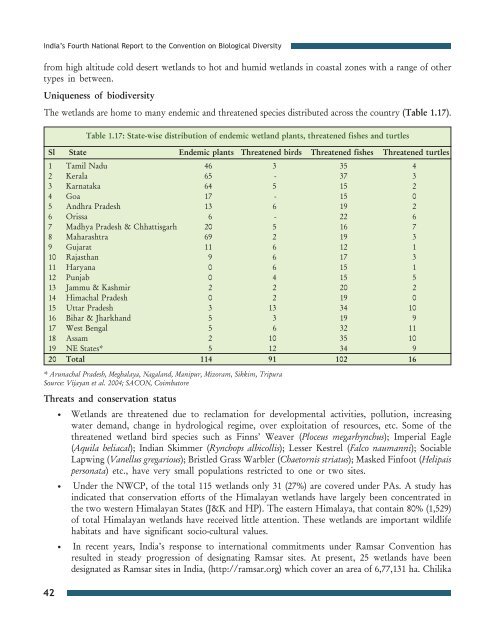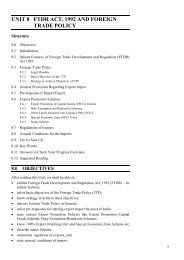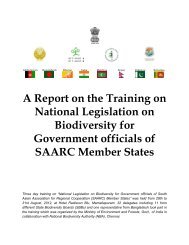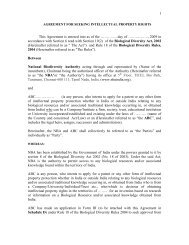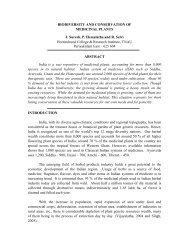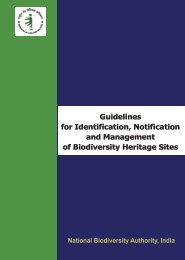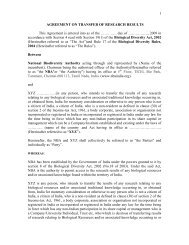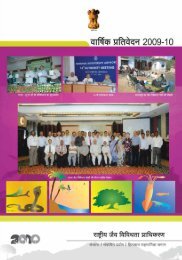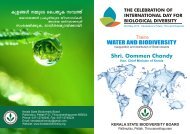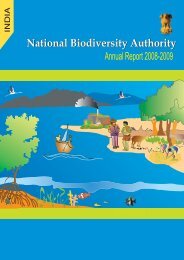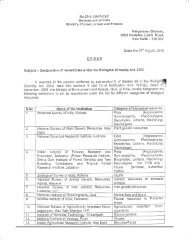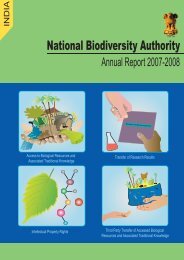Part 1 - English version (PDF) - Convention on Biological Diversity
Part 1 - English version (PDF) - Convention on Biological Diversity
Part 1 - English version (PDF) - Convention on Biological Diversity
You also want an ePaper? Increase the reach of your titles
YUMPU automatically turns print PDFs into web optimized ePapers that Google loves.
India’s Fourth Nati<strong>on</strong>al Report to the <str<strong>on</strong>g>C<strong>on</strong>venti<strong>on</strong></str<strong>on</strong>g> <strong>on</strong> <strong>Biological</strong> <strong>Diversity</strong><br />
from high altitude cold desert wetlands to hot and humid wetlands in coastal z<strong>on</strong>es with a range of other<br />
types in between.<br />
Uniqueness of biodiversity<br />
The wetlands are home to many endemic and threatened species distributed across the country (Table 1.17).<br />
42<br />
Table 1.17: State-wise distributi<strong>on</strong> of endemic wetland plants, threatened fishes and turtles<br />
Sl State Endemic plants Threatened birds Threatened fishes Threatened turtles<br />
1 Tamil Nadu 46 3 35 4<br />
2 Kerala 65 - 37 3<br />
3 Karnataka 64 5 15 2<br />
4 Goa 17 - 15 0<br />
5 Andhra Pradesh 13 6 19 2<br />
6 Orissa 6 - 22 6<br />
7 Madhya Pradesh & Chhattisgarh 20 5 16 7<br />
8 Maharashtra 69 2 19 3<br />
9 Gujarat 11 6 12 1<br />
10 Rajasthan 9 6 17 3<br />
11 Haryana 0 6 15 1<br />
12 Punjab 0 4 15 5<br />
13 Jammu & Kashmir 2 2 20 2<br />
14 Himachal Pradesh 0 2 19 0<br />
15 Uttar Pradesh 3 13 34 10<br />
16 Bihar & Jharkhand 5 3 19 9<br />
17 West Bengal 5 6 32 11<br />
18 Assam 2 10 35 10<br />
19 NE States* 5 12 34 9<br />
20 Total 114 91 102 16<br />
* Arunachal Pradesh, Meghalaya, Nagaland, Manipur, Mizoram, Sikkim, Tripura<br />
Source: Vijayan et al. 2004; SACON, Coimbatore<br />
Threats and c<strong>on</strong>servati<strong>on</strong> status<br />
Wetlands are threatened due to reclamati<strong>on</strong> for developmental activities, polluti<strong>on</strong>, increasing<br />
water demand, change in hydrological regime, over exploitati<strong>on</strong> of resources, etc. Some of the<br />
threatened wetland bird species such as Finns’ Weaver (Ploceus megarhynchus); Imperial Eagle<br />
(Aquila heliacal); Indian Skimmer (Rynchops albicollis); Lesser Kestrel (Falco naumanni); Sociable<br />
Lapwing (Vanellus gregarious); Bristled Grass Warbler (Chaetornis striatus); Masked Finfoot (Helipais<br />
pers<strong>on</strong>ata) etc., have very small populati<strong>on</strong>s restricted to <strong>on</strong>e or two sites.<br />
<br />
<br />
Under the NWCP, of the total 115 wetlands <strong>on</strong>ly 31 (27%) are covered under PAs. A study has<br />
indicated that c<strong>on</strong>servati<strong>on</strong> efforts of the Himalayan wetlands have largely been c<strong>on</strong>centrated in<br />
the two western Himalayan States (J&K and HP). The eastern Himalaya, that c<strong>on</strong>tain 80% (1,529)<br />
of total Himalayan wetlands have received little attenti<strong>on</strong>. These wetlands are important wildlife<br />
habitats and have significant socio-cultural values.<br />
In recent years, India’s resp<strong>on</strong>se to internati<strong>on</strong>al commitments under Ramsar <str<strong>on</strong>g>C<strong>on</strong>venti<strong>on</strong></str<strong>on</strong>g> has<br />
resulted in steady progressi<strong>on</strong> of designating Ramsar sites. At present, 25 wetlands have been<br />
designated as Ramsar sites in India, (http://ramsar.org) which cover an area of 6,77,131 ha. Chilika


